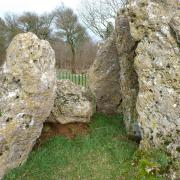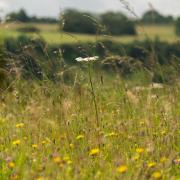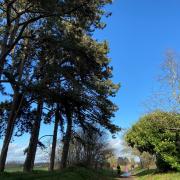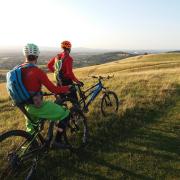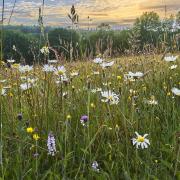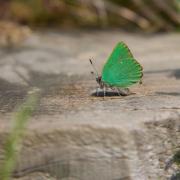We’re heading back into the mists of time, when giants were the only occupants of Britain, to a tale of land-shaping by the two giant brothers of Bristol – one from the Somerset side and one from Gloucestershire.
Long before Bristol existed, the land looked very different. From where Bradford-on-Avon is today all the way to the site of Bristol, a river pooled into a huge lake, presided over by its goddess, Avona. She was loved by the two giants who lived on either side of the Bristol end of the lake: Goram, who lived on the north side in Henbury, and Vincent, who lived in the south, opposite Clifton.
Both these giants were hugely strong and industrious and could move and shape the rock with their bare hands. Vincent was busy in Somerset making things like Maes Knoll, the Stanton Drew stone circle and the Wansdyke. Goram had a different personality. He made himself a giant chair at Henbury and would sit there with a huge jug of cider, watching his brother busying about in the distance.
Avona couldn’t choose between the two brothers, so she set them a challenge. She declared she would marry the one who could dig a channel through the rock so her lake could drain into the Bristol Channel. Goram and Vincent didn’t need telling twice. The two set to work. Vincent started cutting through the rocks in Clifton and Goram started in Henbury. You can visit both of their gorges. Vincent’s is more famous, but we’re going to follow Goram in our walk today.

WALKING NEAR GORAM’S FOOTPRINT
From the Blaise Castle car park, make your way left across the grass to the bend in the drive, then head down the steps towards the Hazel Brook, a tributary of the River Trym. We drop into a small gorge, which is where Goram started to dig. You’ll see, on a rise of the hillfort to your right, an area of bare rock – that’s Goram’s massive footprint. More on that later. Follow the broad path alongside the stream, where Goram dug.
You’ll pass a little mill, its wheel now still and silent, once a paper mill then a flour mill. It’s said the ghost of a girl who drowned there haunts the spot, but there was no mill back in Goram’s day. The giant was getting hotter and sweatier and more tired. Fortunately for him he had a pool in which to get washed. It’s called Tarn Lake. Here Goram soaked away his aches and pains and scrubbed himself with soap from his rocky soap-dish. From this pool, cross to the path on the other side of the brook, and follow our sleepy Goram, still cutting his gorge, along the bottom of the valley.
If you look up to the left, you’ll eventually see his rocky chair looming out of the trees. He climbed up here, poured himself a mug of cider, closed his eyes and fell asleep … You meanwhile can walk on a bit further until you pass a carving on a tree of a Buddha flanked by squirrels, which says: ‘Observe a tree, grow in peace.’ You’ll see a cathedral of beeches stretching up the slope.
Head up the slope and enjoy the view, then follow the path back towards Blaise Castle House. Go past the Woodman’s Cottage down a short switchback. Follow the stream past the house, then turn left. If you have time to visit the church, you’ll be rewarded by Arts and Crafts stained glass by Arnold Robinson and Margaret Chilton.
Follow Church Close, turn left on to Church Lane, and near the end of the lane turn right. Head in front of the museum and back to the car park and café. Or you could first go and take in the 18th-century sham castle on the hill.

VINCENT’S GORGE
Eventually, Goram woke up. When he rose blearily from his chair he saw such a sight. To the south, there was an enormous gorge, far, far bigger than his. It stretched all the way to the sea. Avona’s lake had gone, and her river was flowing into the sea. We know this gorge as the Avon Gorge. Worse than that, there was his brother Vincent with his arms around Avona! Vincent had won the contest while Goram had been sleeping off the cider. Goram was furious. He stamped his foot – creating the footprint you saw early on in the walk – then he grabbed a chunk of rock from his chair and advanced on Clifton towards his brother and his new wife. He shouted out to Vincent to challenge him to a stone-throwing contest, a traditional giant pursuit in the west, and hurled his stone straight at his brother. It fell short. You can still see today the resulting cromlech incongruous in a front garden in Stoke Bishop, now known as the Druid Stone and, in the 19th century when the spot was in the grounds of Druid Stoke House, the site of druidic ceremonies.

THE ACCIDENTAL ISLANDS
Goram was even angrier because his stone had failed to hit his brother. He raced across to Clifton, leapt the gorge, and chased his brother. Sadly, things done in anger don’t often work out well. He tripped over Maes Knoll and flew into the sea, where he died, turning to stone. It’s said that the islands Steep Holm and Flat Holm, which you can still see from Weston-super-Mare, are his head and shoulders.
This story was first recorded in the 16th century by William Camden in his itinerary, Britannia, then expanded in Atkyn’s History of Gloucestershire in the 18th century. Vincent, who is also called Ghyston, was mentioned by the topographer William Worcestre in the 15th century, at which time a figure of the giant cut into the turf may have existed on the hillfort where the Clifton Observatory now stands. It’s said that he and Avona settled down in a little cave, near the location of Brunel’s suspension bridge, to watch her river flowing down to the sea.
This cave and the rocks around it are still named after Vincent, although some pesky commentators suggest that the name may derive from the chapel of St Vincent that was in the cave in the Middle Ages. Some say that it was St Vincent who cut the gorge by means of the power of God, but I prefer to believe in the giants! Why not make a day of it and explore Vincent and Avona’s home down in Clifton, too?
COMPASS POINTS
Distance: Three miles.
Duration: Two hours.
Level: Good paths, some steep climbs.
Parking: Blaise Castle Estate car park, Kings Weston Road.
Toilets and refreshments: Blaise Castle Café.
Transport links: Buses 1, 2 and 3 go from central Bristol.
Further reading: Gloucestershire Folk Tales for Children by Anthony Nanson and Kirsty Hartsiotis




